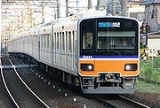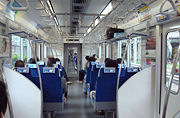
TJ Liner
Encyclopedia

Home Liner
is the generic name given to limited-stop commuter train services operated by railway companies in Japan, which require the purchase of a supplementary or in addition to the base fare ticket. The supplementary ticket guarantees passengers a seat on board...
" service on the Tōbu Tōjō Line operated by Tobu Railway
Tobu Railway
is a Japanese commuter railway company in the Greater Tokyo Area as well as an intercity and regional operator in the Kantō region. It operates in Tokyo, Saitama, Chiba, Tochigi, and Gunma Prefectures...
in Japan since June 2008.
Service outline
TJ Liner services operate in the evenings in the "downRailroad directions
Railroad directions are used to describe train directions on railroad systems. The terms used may be derived from such sources as compass directions, altitude directions, or other directions...
" direction from only, with nine trains on weekdays, and four trains at weekends and holidays. Some trains terminate at , while some trains continue to . A supplement of 300 yen is required for travel from Ikebukuro. Seats are not reserved, but the supplementary tickets indicate whether passengers should ride in the front or rear five cars of the train. A supplementary ticket is not required for passengers boarding at other stations along the line. At Ikebukuro Station, passengers board from platform 5, which is normally used only for passengers alighting from other services.
Station stops
TJ Liner services stop at - - - - - - - - - .Rolling stock

Electric multiple unit
An electric multiple unit or EMU is a multiple unit train consisting of self-propelled carriages, using electricity as the motive power. An EMU requires no separate locomotive, as electric traction motors are incorporated within one or a number of the carriages...
s. These sets are unusual in having rotating pairs of seats allowing them to be used with longitudinal seating on regular daytime services, and with transverse seating on evening TJ Liner services. Some trains are sent to Ikebukuro from Shinrinkōen as limited-stop Rapid Express services.
History
The name "TJ Liner" was formally announced by Tobu on 28 January 2008 based on the results of a public poll conducted between December 2007 and January 2008. The votes for the three choices of possible names were as follows.- TJ Liner (4,313 votes)
- Okaeri Liner (3,148 votes)
- Assist Liner (1,726 votes)
Services commenced from the start of the Tōbu Tōjō Line timetable revision on 14 June 2008, with six trains on weekdays, and four trains at weekends and holidays.
From 15 September 2009, a new new QR Code
QR Code
A QR code is a type of matrix barcode first designed for the automotive industry. More recently, the system has become popular outside of the industry due to its fast readability and comparatively large storage capacity. The code consists of black modules arranged in a square pattern on a white...
ticketing system was introduced for TJ Liner services. From this date, TJ Liner supplementary fare tickets were printed with a QR Code enabling them to be read by special ticket readers at Ikebukuro Station platform gates, replacing the previous manual ticket inspection by staff.
On 5 November 2009, a ceremony was held at Ikebukuro Station to celebrate the 1 millionth passenger to travel on the TJ Liner service.
From the start of the revised timetable on 5 March 2011, the number of TJ Liner services operating on weekday evenings was increased from six to nine. On weekends, all services were extended to run to Ogawamachi.

